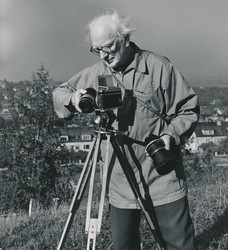Nora Čechmánková
Plicka was born to a family of a businessman (1894, Vienna). He spent his childhood in Vienna and in Česká Třebová. He was a gifted musician and painter. Plicka was an ethnographer, photographer and music theorist. He worked as an executive officer for the ethnographic department of the Matica slovenská between 1924 and 1938. Plicka established an archive for documentary photography in the institution. In 1938, he co-founded the courses of photography and cinematography at the Škola umeleckých remesiel (School of Applied Arts) in Bratislava. He returned to Prague when the Second World War had started. He received a job in the State photometric institute in Prague. In 1949, he became a professor at the Film and TV School of the Academy of Performing Arts in Prague, of which he had become one of the co-founders. He is the author of several books of photography and of films. Plicka received the National Artist title in 1968. He died in Prague in 1987. Since 1988 there has been a museum dedicated to his work in the Slovak village of Blatnica.
As part of his research work in Matica slovenská, Plicka recorded 40 thousand Slovak folk songs, published musicology studies and books. He made recordings (photographs and films) of singers and rural backgrounds. His photographic work refers to the period between the 1930s and 1960s, partly the 1970s. His photographs refer to four main categories: nature, architecture, art and people and their folk traditions. He made realistic photographs with a touch of his creative eye for Slovakia. The first book of his photographs “Slovakia” was published in 1937. Since then, his photographic work has been published in many books.
Plicka had the best equipment for making photos of his time and he also adjusted the camera to suit his needs. He was a master of light adjusting. Perfect location, focal distance and patience to wait for perfect light and weather is the secret of his photographic work.
His films were inspired by his ethnographic research work. He created his first short ethnographic films in 1926. His most popular film Zem spieva/The Earth sings (1933) is a combination of recordings of folk traditions and visual concepts of a film. Plicka was awarded for this film at Biennale in 1934 in Venice.
